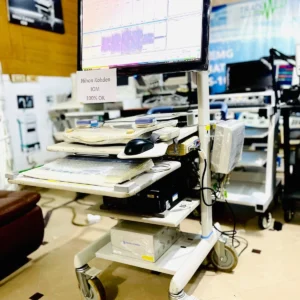Nihon khoden IOM
Nihon Khoden IOM: Revolutionizing Intraoperative Monitoring
In the realm of modern surgery, precision is paramount. Every incision, every maneuver, must be executed with the utmost care to ensure optimal outcomes for patients. In this pursuit of surgical excellence, intraoperative monitoring (IOM) has emerged as a crucial tool, providing real-time feedback on neurological function during procedures. Among the leaders in this field is Nihon Kohden, a company renowned for its innovative medical technologies. With its advanced IOM systems, Nihon Kohden is revolutionizing the way surgeons approach complex surgeries, enhancing patient safety and improving surgical outcomes.
The Importance of Intraoperative Monitoring
Intraoperative monitoring involves the continuous assessment of neurological function during surgical procedures. It allows surgeons to monitor the integrity of the nervous system in real-time, helping to identify and prevent potential complications such as nerve damage or paralysis. By detecting changes in neurological function early, IOM enables surgeons to make immediate adjustments to their surgical approach, minimizing the risk of adverse outcomes.
Introducing Nihon Khoden IOM Systems
Nihon Kohden offers a range of IOM systems designed to meet the diverse needs of surgical specialties. These systems combine state-of-the-art technology with intuitive interfaces, allowing surgical teams to monitor and interpret neurological signals with precision and confidence.
Key Features of Nihon Khoden IOM Systems
- Multi-Modality Monitoring: Nihon Kohden IOM systems integrate multiple monitoring modalities, including electromyography (EMG), somatosensory evoked potentials (SSEP), and motor evoked potentials (MEP). This comprehensive approach provides a more complete picture of neurological function, enhancing the sensitivity and specificity of monitoring.
- Real-Time Data Analysis: With advanced signal processing algorithms, Nihon Kohden IOM systems analyze neurological signals in real-time, allowing for immediate detection of changes in nerve function. Surgeons receive instant feedback on the integrity of neural pathways, enabling timely intervention if necessary.
- Customizable Alerting: Nihon Kohden IOM systems feature customizable alerting mechanisms that notify surgical teams of significant changes in neurological function. These alerts can be tailored to the preferences of individual surgeons, ensuring that critical information is communicated promptly during surgery.
Advantages of Nihon Khoden IOM Systems
- Enhanced Patient Safety: By providing continuous monitoring of neurological function, Nihon Kohden IOM systems help safeguard patients against potential nerve injury or paralysis during surgery. This proactive approach to patient safety can lead to better outcomes and reduced postoperative complications.
- Improved Surgical Outcomes: With the ability to detect and address changes in neurological function in real-time, Nihon Kohden IOM systems contribute to more precise surgical techniques and better outcomes for patients. Surgeons can make informed decisions during surgery, leading to more successful procedures and faster recovery times.
- Streamlined Workflow: Nihon Kohden IOM systems are designed to integrate seamlessly into the surgical workflow, with intuitive interfaces and user-friendly features. This allows surgical teams to focus on patient care without being distracted by complex technical processes, leading to more efficient surgeries and reduced operating room time.
Clinical Applications of Nihon Khoden IOM Systems
Nihon Kohden IOM systems are used in a wide range of surgical specialties, including neurosurgery, spine surgery, orthopedic surgery, and vascular surgery. In neurosurgery, for example, IOM is commonly used to monitor the integrity of neural pathways during procedures such as tumor resection or spinal cord surgery. Similarly, in spine surgery, IOM helps surgeons identify and avoid potential nerve damage while performing complex spinal fusions or decompressions.
Conclusion
Nihon Kohden IOM systems represent the cutting edge of intraoperative monitoring technology, providing surgeons with the tools they need to ensure the safety and success of complex surgical procedures. With their advanced features, intuitive interfaces, and proven clinical efficacy, these systems are transforming the way surgeons approach neurophysiological monitoring in the operating room. As surgical techniques continue to evolve, Nihon Kohden remains at the forefront of innovation, delivering solutions that empower surgical teams and improve patient outcomes.



